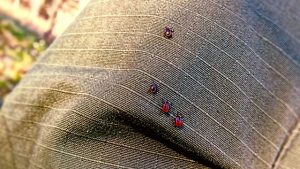
Good day. Some people have a rush to do important things. We have a small pond.
Young people often like to relax there, especially from the city. One day, almost before my eyes, a young man pulled out a tick without special ceremony, which bit his girlfriend.
But to snatch one, and the tick's paws remained in place. They had to seek medical help so that they would be completely removed. Want to know how to get a tick from a person? How to do it right? Then read the article below.
The content of the article:
How to pull out the tick and its head?
The highest tick activity is observed during the spring – summer period and lasts until mid-autumn. Infected ticks are carriers of diseases dangerous to humans.
Having found a tick on the body of a person, it is necessary to immediately take the necessary measures to remove it, since even non-infectious specimens of the parasite can cause serious harm to health.
The right ways to get the parasite
With oil. Using any oil solution (be it vegetable oil, petroleum jelly or cream), we treat the tick-affected area of the skin, including the insect itself. After a minute, with two fingers we pry off the tick body, tilting it to the back, and sharply pull it out.
It is important that the insect is completely removed, since it is often possible to stretch only its body, and the head remains in the wound, causing severe irritation to the skin.
With tweezers. You can get rid of the parasite at home with tweezers. Before this procedure, the bite site should be treated twice: before removing the tick and after.
Using thread. You should take a thread about 20 cm long, fold it in half, pry it off with a loop of a tick and, making swinging and unwinding movements counterclockwise, try to get an insect. To reduce pain before the procedure, you can lubricate the affected area of the skin with oil, and after removing the tick, it will properly treat the skin with iodine.
In a medical facility. If you are not far from a medical facility, it will be wiser to remove a tick from a specialist. Home methods are not always effective, and delaying the removal of the parasite is highly undesirable: the virus secreted by the insect enters the bloodstream gradually, and the sooner help is provided, the smaller the proportion of infection the body will receive. The doctor will correctly and without damage to the patient’s health remove the tick.
How to get your head?
It happens that only part of the tick can be removed, while the head of the arthropod remains deep on the skin. How to pull out a tick in this case?
In order to get the head of the parasite, you need a needle or pin, previously calcined over the flame. Removing the rest of the insect is necessary in the same way as an ordinary splinter.
What to do with the extracted insect?
The extracted parasite should be destroyed: it is best to burn or crush it by pinching it with paper or cloth, since the liquid contained in it can get into small cuts or scratches on the skin when crushed.
If the insect was able to be removed alive, it should be placed in an airtight container and taken to a medical laboratory for analysis.
How to protect yourself reliably?
Before visiting green areas (park, forest, places with dense thickets of grass), you should limit the number of unprotected places on the body. It is advisable to choose clothes with a hood and long cuffs, it should fit snugly to the body and cover it as much as possible.
After returning home, you should carefully examine yourself: especially close attention should be paid to that part of the head that is covered with hair, auricles and inguinal region - favorite places for sucking ticks.
How to independently remove a tick in humans
Tick extraction is a procedure aimed at the complete removal of all parts of the parasite from the victim’s skin. This prevents the attachment of a bacterial infection and promotes the rapid healing of the wound.
Ticks are the oldest arthropods on earth. In total, this class has more than 40 thousand species, which mainly eat plant foods. But some arthropods prefer the blood of animals and humans. They hide in the grass and on the trees and wait for the right moment to cling to the victim's clothes.
After getting on the person’s clothes, the tick creeps up and appears on the head, neck or in the armpits. It is here that the parasite ends its journey, digging into the skin of the victim.
There are many myths associated with tick-borne infections and their livelihoods.
Parasites lay eggs under the skin. In fact, this is not so, in most bloodsuckers the respiratory organs are located on the abdomen, therefore, having sunk deep under the skin, it will stop breathing. Accordingly, the parasite cannot lay any eggs in the human body.
You can be vaccinated against tick-borne infections. In fact, vaccination is carried out against encephalitis, but bloodsuckers are carriers of Lyme disease. No one is vaccinating against this ailment.
If you drip on the tick with fat, it will come out. This does not always work. It is proved that when the respiratory organs are blocked with fat or wax, the tick suffocates, and a lot of saliva is injected into the victim’s blood, which may contain infectious agents.
Ticks live only in the forest. This is not so, although arthropods prefer a humid and warm climate. Ticks can be found in the city park, near the river and even in the square where children play.
If it enters the human body, the parasite immediately bites the victim. No, an arthropod can crawl for hours on clothes and body in search of a cozy place. Most often, ticks are attached in the armpits, between the buttocks and on the head. Here the skin is very thin, there are a lot of blood vessels.
Parasites live only in the summer. This is also a myth, since the peak of activity falls in May-June and September-October. Parasites also do not tolerate heat above 30 ° C. Cases of activity of bloodsuckers were recorded in November and March. At temperatures below + 4 ° C, the mites hibernate.
Tick can be easily seen on the skin. It all depends on the stage of development of the parasite. The diameter of the larva is only 0.5 mm; accordingly, it is very difficult to detect. The insect increases 10 times when saturated with blood, but an adult may need 11 days for this.
The parasite can be easily removed with your fingers. This can’t be done, because you can just tear the insect and leave a head or proboscis in the skin. In addition, the fingers do not allow due to their thickness to completely cover the tick.
How to get rid of a bloodsucker
A tick must be removed from the skin, since prolonged contact of the proboscis of the parasite and tissues is fraught with infection with encephalitis and other dangerous ailments. There are many ways to get a tick correctly, for this it is not necessary to go to the hospital.
How to pull out a syringe
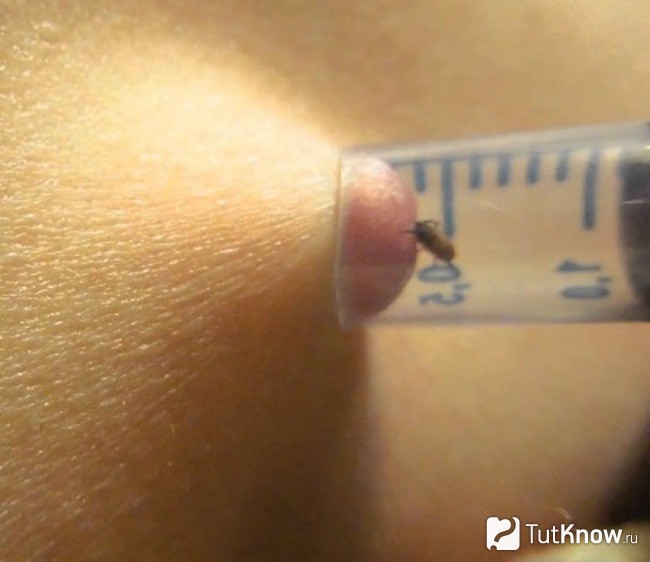
The most important thing is not to leave part of the parasite in the skin and not break it. The fact is that the proboscis of the insect is very sharp, firmly sticks to the surface, and accordingly it cannot be removed by simply pulling or tearing it. You risk crushing the insect into pieces and make it worse for yourself or your family.
Accordingly, to extract the insect, choose methods that will preserve the integrity of the parasite. One of these methods can be considered removal by a syringe. This method can be considered one of the best, since it allows you to maintain the integrity of the insect and exclude the possibility of inflammation.
Instructions for removing ticks with a syringe:
- Find the place where the tick is attached. The skin in this area is red, a rounded spot. In the vinegar area, itching and burning are felt. The body of the tick can protrude and hang outside, and the head is under the skin.
- Take an insulin or five-cube syringe. It is advisable to take products with a rubber piston, the pressure necessary for sucking out the parasite is created inside.
- Cut off the nose and the beginning of the syringe with a very sharp knife or blade. As a result, you get a thin tube with a piston.
- Moisten the bite site with water or PVA glue. This will provide the necessary level of grip and create a vacuum.
- Attach the syringe with the cut to the skin and slowly pull out the piston. You need to press on the tube. As a result, you get a “bubble” of absorbed skin.
- Due to pressure, the body of the tick with the head will come out.
- Treat the site of redness with alcohol or hydrogen peroxide.
- If the temperature after removing the tick does not drop for several hours, call an ambulance.
How to pull out the remainder of the tick with a needle
Often, women with the help of sharp and long nails try to extract the tick. Often this ends with a rupture of the parasite, respectively, the head and proboscis remain in the human body.You can’t leave insect scraps, it is fraught with inflammation, abscess and even blood poisoning. It is mandatory to remove all parts from the body.
Instructions for removing the tick head with a needle:
- The tick head has the most poison, which causes inflammation and swelling of the bite area. You can use a thin needle to extract.
- Hold the needle over the fire, the flame of a gas burner, candle or lighter will do. The “tool” should darken.
- Lubricate the bite with alcohol, rinse the needle with an antiseptic. Put on gloves and gently insert the needle under the black speck or strip.
- Lift up the needle and remove part of the tick. In no case do you need to tear the wound and make it more like a needle. If you are unable to pull out the remainder of the insect, consult your doctor.
In most cases, the victim only picks up the bite and makes it a great haven for infections and germs. It is in such cases that a bacterial infection often joins along with poisoning.
How to remove a tick, if the head remains, with tweezers
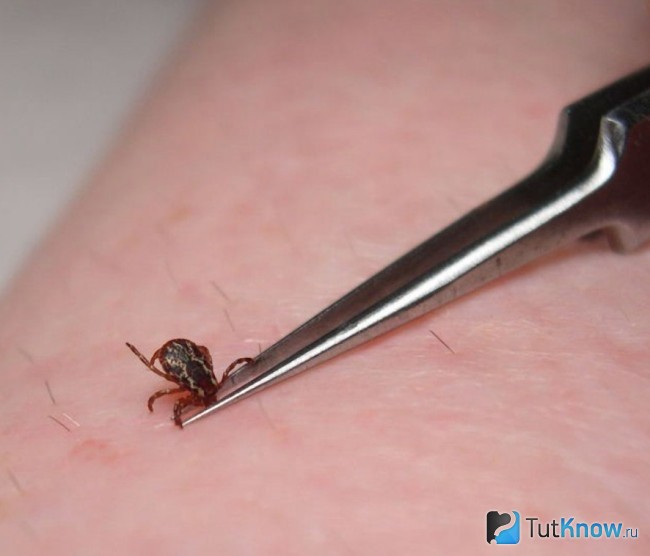
There are several ways to remove the tick head from the skin of the victim at home. If you see the head, and it is not deep under the skin, then try to remove it with tweezers.
Instructions for removing the tick head with tweezers:
- Lubricate the damaged area with alcohol or peroxide. Put on gloves and treat them with any antiseptic.
- Take eyebrow tweezers with sharp, thin halves and press into the skin.
- Squeeze the tweezers, remove the rest of the parasite from the skin. This must be done with twisting movements.
- Fill the place with brilliant green or iodine.
Often, doctors at the emergency room refuse to remove the tick head and recommend covering the affected area with iodine. Typically, part of the parasite comes out with pus within 1-3 weeks. But you don’t have to wait.
Be sure to take the remnants of the tick to the laboratory to check it for encephalitis!
How to remove a tick with oil
Experts do not recognize this method and consider it unsafe. The fact is that by blocking the tick’s breathing, you can provoke it to plunge even deeper into the skin, and it will be very difficult to get it.
Oil Removal Instructions. On the back of the parasite are respiratory organs that can be clogged using vegetable oil.
Put a few drops of vegetable oil on the tick. This must be done with a syringe or pipette. Wait a few minutes. The tick after blockage of the respiratory system will weaken the jaw, and you can remove the parasite with minimal resistance.
Without your actions, the insect will not go anywhere and will not come out of the skin. After using the oil, you need to pull out the insect using tweezers with twisting movements.
You can’t leave the tick on the body, even if after using the oil it has stopped moving its paws and does not show signs of life. This place can be an excellent breeding ground for bacteria. Treat the bite site with an antiseptic and glue the patch.
After oil treatment, the insect will not be taken for examination, as this will not allow to obtain reliable results.
How to pull a tick in a person with a thread
A thread is an excellent tool for removing a tick if there are no tweezers and special items to remove.
Thread removal instructions:
- You need a thick and durable thread. A cloth will do. You should not take thin and silk threads, you risk cutting the body of the insect with fibers and leaving its head and proboscis under the skin of the victim.
- Make a loop of thick thread, leaving the ends of the same length on both sides.
- Draw a loop on the body of the bloodsucker, after pressing the thread to the skin.This will allow the thread to be attached as close to the head as possible and the insect will be completely removed.
- Tighten the thread and swaying movements, pulling a little, remove the tick. No need to sharply tear the thread, do everything very carefully and with short breaks.
- In most cases, the insect loosens its jaws and tries to get out of the victim’s tissues. After removing the bloodsucker, treat the wound with alcohol or an antiseptic.
Special Extraction Tools
Now in our country and abroad, production has been established for the production of special products for the extraction of ticks from the skin of an animal or human. All these devices have certain advantages over the use of thread and tweezers. The body and the head of the tick do not squeeze when gripping devices, respectively, so you will be able to extract a whole bloodsucker with 100% probability without leaving the head or proboscis inside.
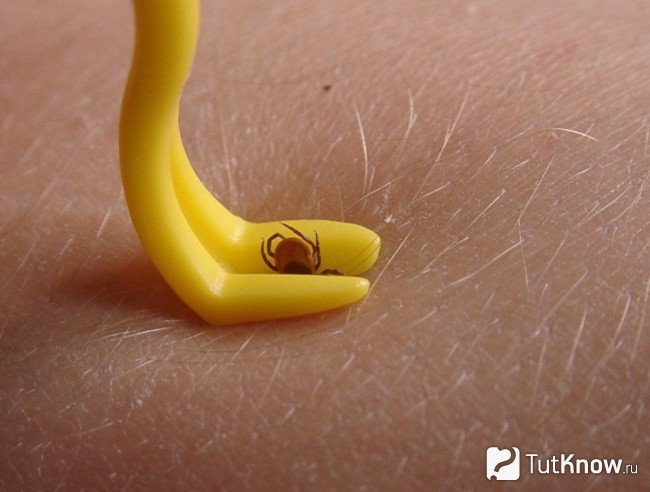
The list of devices for removing ticks:
Tick Twister. This is a plastic item, somewhat reminiscent of a nail clipper. It looks like a fork with two cloves and a slot in the middle. Two “forks” of different sizes are sold in the kit to remove large and small bloodsuckers. You just need to press the hook to the body and hook it with a tick.
Tick Nipper This device resembles a pair of pliers made of plastic. The working part of the device is two cloves that, when connected, resemble a bowl. It is necessary to squeeze the insect between the teeth and twisting movements to extract from the body of the victim. The device is manufactured in the USA, its cost is 5-8 dollars.
Pro Tick Remedy. The device is a metal plate with a slot. Included is a magnifier with a fivefold increase. This allows you to capture the tick as deep as possible. You just need to hook the insect with a plate and, swaying from side to side, remove it. Cost - 3 dollars.
Ticked Off. This device resembles an ordinary plastic spoon with a slot. It is necessary to pick up the insect with a spoon and put it in the narrowest place of the device. After that, very slowly the spoon rises perpendicular to the body. In Russia, this device is not for sale in pharmacies; it can be purchased in online stores. The cost of the product is 3-5 dollars. There is a loop at the tip of the handle to put on the keys.
After removing the parasite, it is advisable to contact the emergency room. Elderly people and children are especially prone to infection.
How to independently and correctly pull out a tick in an adult and a child
There are many ways to get a tick that has digged into the skin while walking in nature. Currently, many people with the onset of warm weather allocate at least a day to relax in nature, but it can be very dangerous.
The thing is that often ticks that wake up with the onset of spring, attacking a person, transmit pathogenic microorganisms to their victim through saliva. And microorganisms are a source of diseases that, without proper treatment, can cause disability and even death of the victim.
Although this procedure may seem simple to some, there are certain rules that must be taken into account in order to safely remove the parasite.It is possible to effectively remove a tick from a person not only with special forceps and clamps that are sold in the pharmacy, but also with the help of improvised tools.
Precautions before the procedure
Ticks are dangerous precisely because during a bite they can transmit pathogenic microorganisms to a person that can provoke serious diseases, including Lyme disease and tick-borne encephalitis.
However, dangerous viruses and bacteria can also be transmitted to humans during the removal of a harmful tick. In order not to get infected during removal of the tick, the parasite cannot be torn apart, since its hemolymph can be a source of infection.
When performing the tick removal procedure at home, be sure to wear gloves and in no case should you touch the insect with your bare hands. If, nevertheless, a person touches a tick, he needs to thoroughly wash his hands with soap and try not to touch them with eyes and mucous membranes.
Among other things, it must be borne in mind that the tick does not bite a person in the full sense of the word, but is screwed into the skin, moving clockwise. Thus, in order to prevent rupture of the parasite, it must be twisted by moving counterclockwise.
When trying to remove a tick, you should not press on it or yank it, since the body of the parasite is fragile enough and with improper movement the proboscis and the entire head of the insect can remain in the wound made by it.
Given that the tick can deepen its proboscis and head a few millimeters into the skin, removing them when separated from the body will be quite problematic. At the same time, if a part of the parasite remains in the wound, this will significantly increase the risk of infection of the victim with pathogenic microflora, which could be a tick carrier, and can also provoke suppuration.
Using special tweezers or a clamp
Considering that in most cases a person discovers a parasite upon arrival home, this gives some advantages, since it is possible to remove a tick at home using special devices or tweezers available in the medicine cabinet.
It is extremely simple to get a tick with such a device. First you need to carefully pass the body of the tick between the teeth of the tool, slightly pressing it on the skin. Next, a slight counterclockwise rotation should gradually remove the tick. Pressing or pulling a tick with such a tool is not worth it.
As a rule, one complete turn is enough to get rid of the body of the parasite without tearing off its head and proboscis. During hiking, it is advisable to take such a tool to remove ticks with you.
Correctly pulling out a tick in humans at home can also be done with tweezers. This tool is extremely convenient for the procedure, but its use requires some accuracy.
Removing a tick at home with tweezers involves the accurate capture of an insect in the area of transition of its body to the head and the gradual twisting of the hands against the clock. If there are no tweezers with rounded bent ends, any tool can be used, but its ends should be wrapped with gauze or cloth so that the metal does not tear the parasite.
Since it is quite simple to pull out a tick at home with tweezers, often this is the tool people take with them who want to go on a picnic in order to remove the parasite if necessary.
The use of ordinary thread and other improvised means
When you need to quickly figure out how to properly remove the tick in the field, and there is no equipment necessary for this, the best tool is a thick thread. The thread should be at least 20 cm in length.
The entire procedure should be carried out very carefully, since the thread can cut the body of the parasite in half. It is necessary to remove the tick from the body so that it does not leave its head and proboscis in the skin. All manipulations should be carried out slowly and without sudden movements. You can pull out the tick with your own thread and in the field.
If you don’t have a thread that could pick up a tick, and no other tools that would be useful in this matter, you can use a transparent plastic bag, in which tourists usually wrap food. Put the bag on your hand so that it hangs freely on your fingers. Next, gently grab the tick and begin to twist it.
It is worth noting that when using a plastic bag it is not always possible to completely remove a tick from a person, since in most cases it does not work out to calculate the strength, which leads to damage to the insect. However, if you do not try to pull out the insect in jerks or just too quickly, it is quite possible to tear off the tick from the human body completely.
What methods are not suitable?
Some people who rarely encounter ticks prefer alternative methods to eliminate ticks, which may be unsafe. In some cases, such methods are indeed effective, but under certain conditions they can cause the death of the tick and increase the risk of infection of human blood with pathogenic microorganisms, the carrier of which was the parasite.
Such folk remedies include:
- soap solution;
- vegetable oil;
- moxibustion
- alcohol;
- vinegar.
Soap solution and vegetable oil contribute to clogging the spiracles of the tick, due to which it can begin to move back. Despite the fact that the use of oil can really make a tick leave a person’s body, it is not worth using it, because due to a lack of oxygen, an insect can burp part of the drunk blood back into the wound, which will significantly increase the risk of infection with pathogenic microflora.
Among other things, a tick can simply die before it can get out of the wound, which will greatly complicate the process of extracting it.
Cauterization of the tick in the vast majority of cases does not contribute to its elimination. Indeed, if during such a procedure the insect is not badly damaged, it can pull out its proboscis, but if the mite died when exposed to a significant temperature, it can be quite difficult to remove.
The use of chemicals to cauterize a tick can also lead to its death. Removing a tick from the human body requires accuracy, so do not use aggressive means to carry out this procedure.
Since it is possible to correctly remove a tick in humans at home using more rational methods, it is best not to resort to folk remedies, which do not always have the necessary effect. If you do not have the necessary tools at hand to safely eliminate the tick, it is better to seek help at the emergency room, where the parasite will be removed quickly and without the risk of complications.
How to properly remove the pest's torn head from the skin
If it was not possible to completely remove the tick from the human body and the head, along with the proboscis of the parasite, remained in the wound, it is necessary to take measures aimed at eliminating the remaining parts of the body of the insect. An ordinary needle is best suited for this purpose.
In addition, the needle itself must also be thoroughly treated with an antiseptic. It is necessary to remove the remnants of the tick as if it were a splinter. Given that the proboscis and the head of the insect are black, removing them from a shallow wound with a needle will be quite simple. Often it is simply impossible to completely eliminate the remnants of the tick on your own, so the help of medical workers is needed.
In no case should you leave parts of the parasite in the wound, since in the vast majority of cases this causes suppuration and, under certain conditions, can lead to sepsis.
Wound treatment
After the body of the tick is completely removed from the wound made by it in the skin, it is necessary to disinfect the site of the bite, as this will significantly reduce the risk of developing serious diseases. For processing, you can apply:
- iodine;
- alcohol;
- hydrogen peroxide;
- zelenka.
Processing the site of a tick bite must be carried out very carefully. After the wound is treated with an antiseptic, it is still necessary to consult a doctor for the introduction of immunoglobulin, as this will prevent the development of such a dangerous disease as tick-borne encephalitis.
If the tick was able to get the whole, it should be placed in a sealed container and submitted for analysis to find out if it was a carrier of certain diseases.
help yourself
Tick bites do not always require medical intervention, since in most cases this insect can be removed on its own. Just follow a few basic rules to know how to properly remove ticks and protect yourself from dangerous viral infections: Lyme disease, encephalitis and tick-borne anaplasmosis.
Currently, in pharmacies you can buy various devices that facilitate the removal of an intruder from the surface of the skin - it can be special tweezers, a suction cup and even a lasso. If you are unable to remove the insect yourself, contact the emergency department.
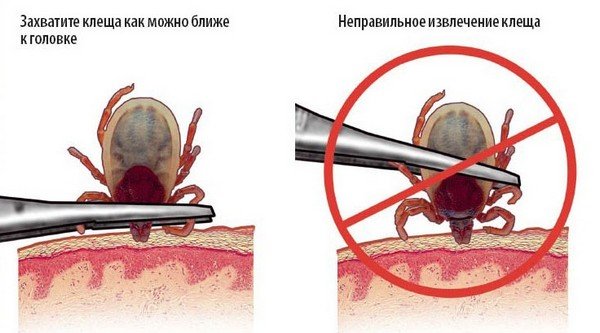
Removal step by step
Here is a detailed action algorithm for removing a tick:
- sterilize sharp forceps to remove ticks (a miniature suction pump or plastic “tongs” available in pharmacies can become an alternative to forceps);
- grab the tick with a tool as close to the surface of your skin as possible;
- gently but persistently pull the insect up;
- after removing the tick, place it on a piece of paper and check if you managed to remove all its organs;
- disinfect the bite area with alcohol or any other antiseptic, apply gauze for some time to the sore spot;
- after removing the tick, wash your hands thoroughly and sanitize the bite again;
- if disturbing changes appear on the skin, consult a doctor.
What not to do when removing a tick?
During tick removal, it is very important to avoid mistakes:
- Never touch a tick for its swollen abdomen, because there is a risk that it will burst and all infected fluid will enter your bloodstream;
- Never “unscrew” an insect when removed, because its head remains in your body;
- Do not try to strangle the tick with petroleum jelly, vegetable oil, nail polish, gasoline or alcohol. During such manipulations, you will cause vomiting in the tick, which only increases the risk of infection;
- Never remove the parasite with your bare hands, eyebrow tweezers and other accessories that are not intended for these purposes - there is a risk that only the stomach is removed and the head and body of the tick remain in the skin (which, again, we recall, can have dangerous consequences for health).
Not in every case, the process of removing the tick goes perfectly according to plan. Sometimes additional questions and problems arise.
What to do if the head of the tick remains in the skin?
It happens that when the tick is removed, the insect's head remains in our skin. Do not panic - the fact is that the remaining organ does not increase the risk of tick-borne encephalitis infection or Lyme disease, because after separation of the head from the body of the insect, bacteria cannot penetrate our blood.
Under no circumstances should you cut your skin, because such an action can provoke a bacterial infection.
In what cases should I see a doctor?
After removing the tick, it is necessary to monitor the condition of your skin and the body as a whole over the next month. The following symptoms should be the reason for going to the hospital:
- the so-called migratory erythema (creeping), which usually develops 3-30 days after a tick bite. Erythema (redness of the skin) is the first symptom of one of the tick-borne diseases - Lyme disease. Initially, erythema has the appearance of red spots that grow rapidly;
- temperature;
- flu-like symptoms (severe headache, muscle and joint pain, cough), which may be a sign of anaplasmosis;
- dizziness, loss of consciousness;
- visual impairment and coordination.
If these symptoms occur, you should immediately consult a doctor and take appropriate tests.
Is there a need to carry the tick to the laboratory?
Many sites are advised to carry the removed tick to the laboratory to check for infections. Is this an important measure?
If you successfully and promptly removed an intruder, the risk of infection is reduced to almost zero. Therefore, you can simply throw away the tick without bothering to go to medical facilities. In most cases, ticks are harmless.
How to get a tick in a person - first aid
With the arrival of heat: in spring and summer, the activity of ticks increases. It also persists until the cold snap.
Even in autumn, there is still a great chance to bring home from a walk in the woods or in a tick park. How to pull out the insect yourself, let's take a closer look.
First you need to understand the importance, in no case should you take action if you are not confident in your abilities or are afraid of insects. You need to understand how dangerous a “little bug” can be that has stuck into your skin.
In order for the manipulation to pass quickly and successfully, it is necessary to prepare the following tools and materials:
- tweezers or small forceps;
- antibacterial soap;
- alcohol;
- cotton pad.
How to get rid of an insect
Carefully examine yourself, this insect likes to settle in hard-to-reach places: it is the groin, armpits, as well as the ankles and head. In all these places, the skin is thinner.
You can remove it yourself only if you can easily get to this place. If the tick digs into the scalp, you will have to ask a friend. Hands should be washed thoroughly with antibacterial soap, wipe the tweezers with alcohol.
Position the sharp edges of the instrument near the mouth of the insect. It is important to capture this particular part, and the body is easier to extract. Be careful not to pinch your head, because when removed, the tick may release dirty saliva under the skin.
After you gently grab the insect head with a tool, very carefully pull the tick up. Do it very slowly, do not rush. It is very important not to accidentally crush an insect.
Avoid twisting for the same reason, because very often when removing the tick with tweezers and twisting the body, it can be easily damaged, and this is very dangerous for human health.
How to remove a tick with soap
There are several ways to extract the tick. You can also get it with soap and a cotton swab if there are no tweezers at hand.
How to do it:
- A cotton swab should be moistened in a strong soapy solution.
- Take cotton wool in your hands and spread it so that it turns out to capture the tick with your fingers.
- And now, very carefully, start, without squeezing the soap wool from the parasite, scroll the insect counterclockwise.
- If the tick did not have time to suck heavily, then it will easily come out.
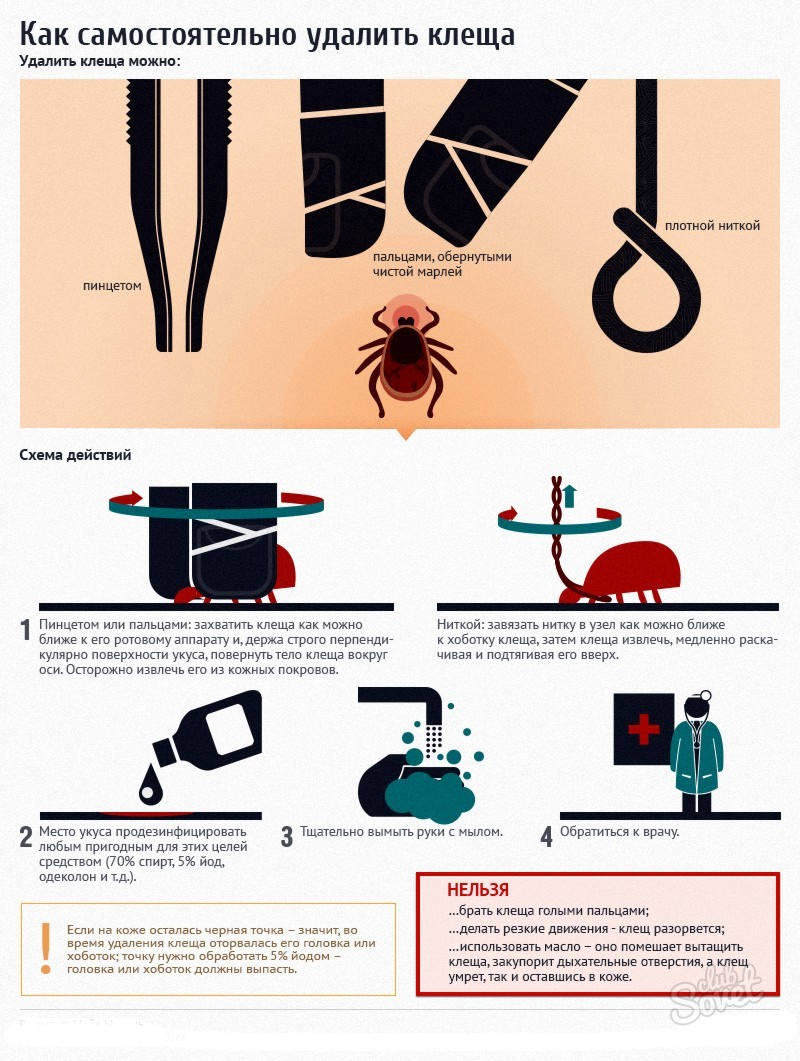
How to remove a tick with a thread
This method is also used by medical workers, because with the help of an ordinary strong thread, you can quickly remove the tick, without damage.
How to do it:
- Take a strong thread.
- Wrap it around the head of the insect closer to the proboscis several times, making a loop,
- To stretch the tick, you need to swing the thread from side to side and gradually raise it up.
You will feel how the tick begins to gradually come out, then you can slightly pull the thread up to remove it completely out.
What absolutely can not be done when removing the tick
Many people believe that the tick should be filled with oil, then it will come out “like clockwork”. But this opinion is erroneous, because he can suffocate before you pull it out and can return some of the blood that you sucked back to the wound. And this is a direct path to the spread of infection.
Pull the tick sharply with your fingers - a great chance to tear it apart. Also, you can not crush the insect with your fingers, pick with a needle and other sharp objects.
And then what
After it has been possible to successfully extract the insect, it is necessary to treat the wound with an antiseptic. It can be zelenka or iodine, as well as an alcohol-containing solution or medical alcohol.
Remember to sanitize the instrument and hands. Hands still need to be washed thoroughly with soap and rubbing with alcohol.
Also, the tick can be burned if it is not possible to deliver the insect to a medical facility.
leave a comment